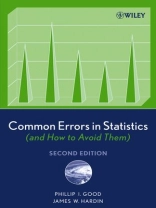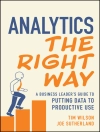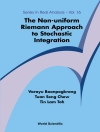Praise for the First Edition of Common Errors in Statistics
‘ . . . let me recommend Common Errors to all those who interact
with statistics, whatever their level of statistical understanding
. . . ‘
–Stats 40
‘ . . . written . . . for the people who define good practice
rather than seek to emulate it.’
–Journal of Biopharmaceutical Statistics
‘ . . . highly informative, enjoyable to read, and of potential use
to a broad audience. It is a book that should be on the reference
shelf of many statisticians and researchers.’
–The American Statistician
‘ . . . I found this book the most easily readable statistics book
ever. The credit for this certainly goes to Phillip Good.’
–E-STREAMS
A tried-and-true guide to the proper application of
statistics
Now in a second edition, the highly readable Common Errors in
Statistics (and How to Avoid Them) lays a mathematically rigorous
and readily accessible foundation for understanding statistical
procedures, problems, and solutions. This handy field guide
analyzes common mistakes, debunks popular myths, and helps readers
to choose the best and most effective statistical technique for
each of their tasks.
Written for both the newly minted academic and the professional who
uses statistics in their work, the book covers creating a research
plan, formulating a hypothesis, specifying sample size, checking
assumptions, interpreting p-values and confidence intervals,
building a model, data mining, Bayes’ Theorem, the bootstrap, and
many other topics. The Second Edition has been extensively revised
to include:
* Additional charts and graphs
* Two new chapters, Interpreting Reports and Which Regression
Method?
* New sections on practical versus statistical significance and
nonuniqueness in multivariate regression
* Added material from the authors’ online courses at
statistics.com
* New material on unbalanced designs, report interpretation, and
alternative modeling methods
With a final emphasis on both finding solutions and the great value
of statistics when applied in the proper context, this book is
eminently useful to students and professionals in the fields of
research, industry, medicine, and government.
Tabela de Conteúdo
Preface.
PART I FOUNDATIONS.
1. Sources of Error.
Prescription.
Fundamental Concepts.
Ad Hoc, Post Hoc Hypotheses.
2. Hypotheses: The Why of Your Research.
Prescription.
What Is a Hypothesis?
How precise must a hypothesis be?
Found Data.
Null hypothesis.
Neyman-Pearson Theory.
Deduction and Induction.
Losses.
Decisions.
To Learn More.
3. Collecting Data.
Preparation.
Measuring Devices.
Determining Sample Size.
Fundamental Assumptions.
Experimental Design.
Four Guidelines.
Are Experiments Really Necessary?
To Learn More.
PART II HYPOTHESIS TESTING AND ESTIMATION.
4. Estimation.
Prevention.
Desirable and Not-So-Desirable Estimators.
Interval Estimates.
Improved Results.
Summary.
To Learn More.
5. Testing Hypotheses: Choosing a Test Statistic.
Comparing Means of Two Populations.
Comparing Variances.
Comparing the Means of K Samples.
Higher-Order Experimental Designs.
Contingency Tables.
Inferior Tests.
Multiple Tests.
Before You Draw Conclusions.
Summary.
To Learn More.
6. Strengths and Limitations of Some Miscellaneous Statistical
Procedures.
Bootstrap.
Bayesian Methodology.
Meta-Analysis.
Permutation Tests.
To Learn More.
7. Reporting Your Results.
Fundamentals.
Tables.
Standard Error.
p-Values.
Confidence Intervals.
Recognizing and Reporting Biases.
Reporting Power.
Drawing Conclusions.
Summary.
To Learn More.
8. Interpreting Reports.
With A Grain of Salt.
Rates and Percentages.
Interpreting Computer Printouts.
9. Graphics.
The Soccer Data.
Five Rules for Avoiding Bad Graphics.
One Rule for Correct Usage of Three-Dimensional Graphics.
The Misunderstood Pie Chart.
Two Rules for Effective Display of Subgroup Information.
Two Rules for Text Elements in Graphics.
Multidimensional Displays.
Choosing Graphical Displays.
Summary.
To Learn More.
PART III BUILDING A MODEL.
10. Univariate Regression.
Model Selection.
Estimating Coefficients.
Further Considerations.
Summary.
To Learn More.
11. Alternate Methods of Regression.
Linear vs. Nonlinear Regression.
Least Absolute Deviation Regression.
Errors-in-Variables Regression.
Quantile Regression.
The Ecological Fallacy.
Nonsense Regression.
Summary.
To Learn More.
12. Multivariable Regression.
Caveats.
Factor Analysis.
General Linearized Models.
Reporting Your Results.
A Conjecture.
Decision Trees.
Building a Successful Model.
To Learn More.
13. Validation.
Methods of Validation.
Measures of Predictive Success.
Long-Term Stability.
To Learn More.
Appendix A.
Appendix B.
Glossary, Grouped by Related but Distinct Terms.
Bibliography.
Author Index.
Subject Index.
Sobre o autor
PHILLIP I. GOOD, Ph D, is Operations Manager of Information
Research, a consulting firm specializing in statistical solutions
for private and public organizations and has published eighteen
books.
JAMES W. HARDIN, Ph D, is Associate Research Professor in
the Department of Epidemiology and Biostatistics at the University
of South Carolina.












